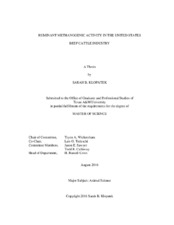| dc.description.abstract | In the U.S., gastrointestinal fermentation from cattle is estimated to account for approximately 25% of total anthropogenic related methane (CH4) emissions. In addition, 2-8% of gross energy consumed by cattle is lost in the form of CH4, representing an energetic cost to the animal. Thereby, in order to decrease greenhouse gas emissions (GHG) and improve the efficiency of cattle production additional research on gastrointestinal CH4 emissions from cattle is needed. In ruminants carbohydrate (CHO) catabolism and nitrogen (N) utilization have a tremendous impact on ruminal methanogenesis. However, the impact of purified carbohydrates in the presence of a variety of N sources on rates of CH4 and VFA production remains unknown. In order to determine these rates for use in predictive models of the ruminal fermentation, we formulated a fractional rate equation to fit the rate of CH4 production and measured the concentration of CH4 and VFA and using purified CHO with a variety of N sources in two in vitro mixed ruminal microorganism fermentation studies. In both studies, a CHO treatment × incubation time (IT) effect was observed for both VFA and CH4 (P < 0.01). There was also an N × IT interaction for CH4 production at 24 h in Study 2, where nitrogen free and NH3 treatments produced greater concentrations of CH4 than treatments with amino acids (P < 0.01). A nonlinear equation for the conversion of carbohydrates to CH4 was able to fit starch treatments in Study 1 and glucose treatments in Study 2. Overall, this study demonstrated different fermentation patterns among all CHO and N sources and was the first step in determining rates for in vitro CH4 production. Although cattle contribute with high amounts of anthropologic GHG, they are not the only methanogenic producing food source in the U.S. Rice and wild ruminants (e.g. bison, elk, and deer) are also methanogenic producing food sources. The objective of this final study was to compare the efficiency of beef and milk production to pre-settlement wild ruminants and rice production on a kilogram of CH4 emitted to kilogram human-edible protein production basis. Bison had the highest ratio of 13.93 kg CH4: Protein, followed by elk (12.50) deer (6.66) and beef (2.47). Overall, wild ruminants emitted 296 to 564 percent more CH4 per kilogram of human-edible protein produced than current beef cattle production systems. Rice yielded the second lowest CH4 to human-edible protein ratio (0.83), followed by dairy cattle milk production (0.50). We believe, this analysis provides insight on the efficiency of methanogenic food sources that may aid in the development of regulatory guidelines of CH4 production. | en |


